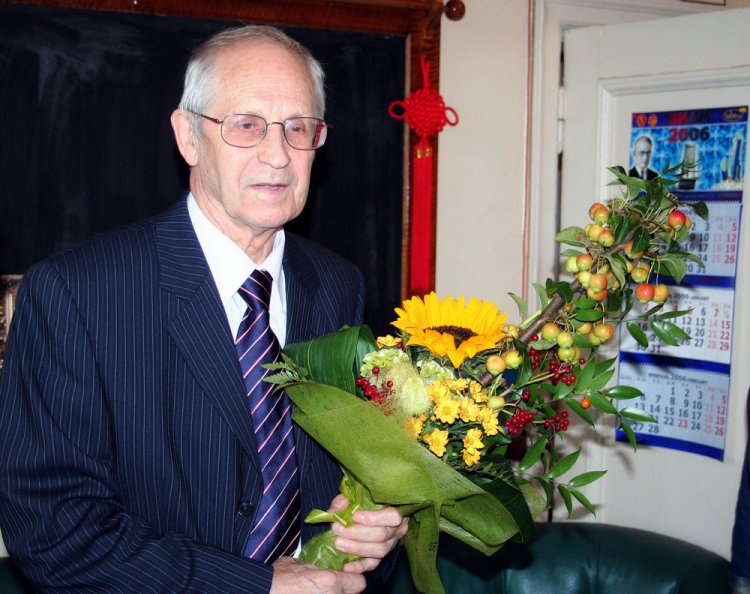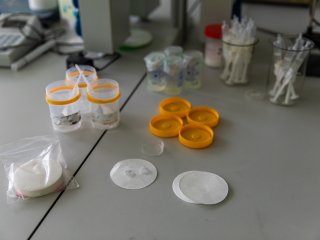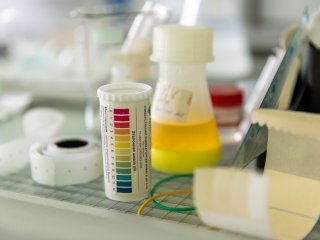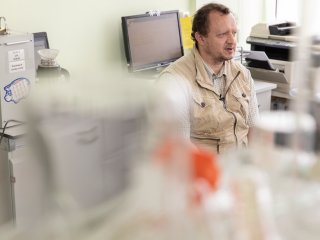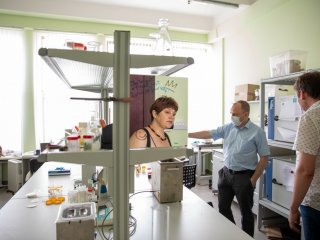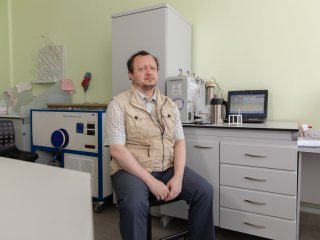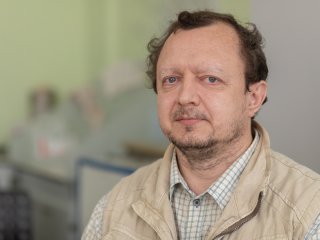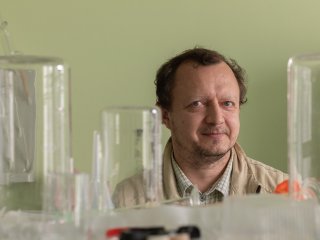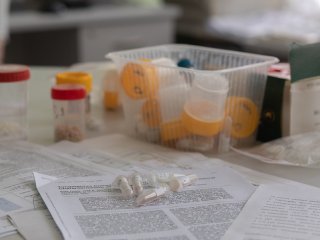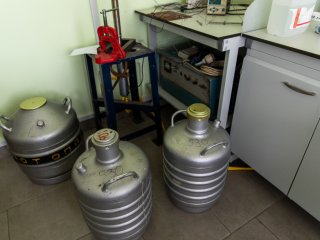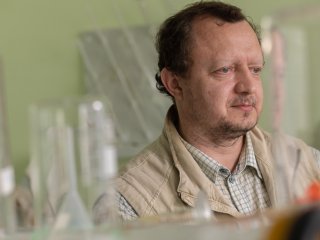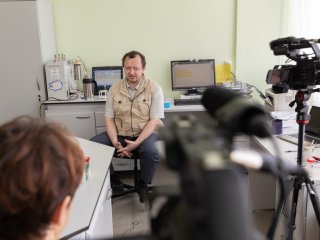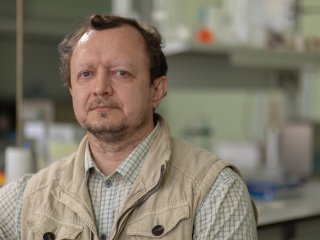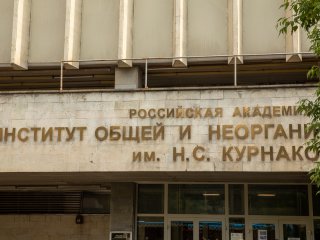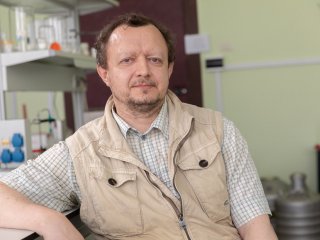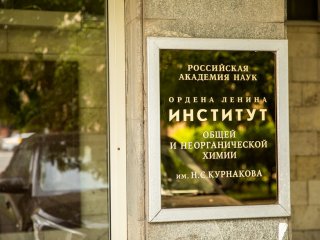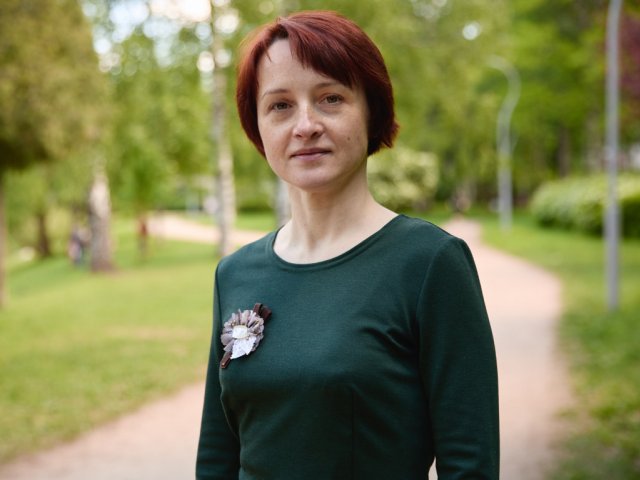How does modern chemistry make it possible to obtain materials with promising features? Where can small particles capable of diagnosing and treating horrible diseases simultaneously find their niche in the epoch of biotechnologies?
These issues are highlighted by Yevgeny Alekseyevich Gudilin, doctor of chemistry, RAS correspondent member, deputy dean at the Faculty of Material Sciences, professor at the Chemical Faculty of Moscow State University (MSU).
– I represent two faculties at the Moscow State University: chemical one that I have graduated from, and the faculty of material sciences, which will be 30 this year. These are the most important landmarks of force and inspiration in my biography, yet the main thing that brings them together is chemistry, as in the science studying materials it all starts with the chemist who pursues the goal of making something interesting, good and eternal.
– Yevgeny Alekseyevich, a far as I know, you and your colleagues are active in studying materials related to human health, theranostics. How did you come to this field of chemistry?
Y.A. Gudilin on levitating magnetic disk over high-temperature superconducting cuprates with perovskite structure (Japan, 1998)
– The way was not easy. It is an extremely specific area, though very sought-after. It is probably the most established one as well. Initially, I was a specialist in inorganic chemistry studying various promising materials with perovskite structure. Now, I continue to deal with them too, but the area you have mentioned is about cooperation with different, very interesting people – brothers-in-arms both inside the university and our native Institute of General and Inorganic Chemistry (IGIC), which is closely connected with both Chemical Faculty and Material Sciences Faculty of MSU.
– The one where we are now, isn’t it?
– Yes, we are now at the modern laboratory of this institute. Theranotics that you have mentioned is an interdisciplinary field of chemistry, material science, biology and medicine which develops and implements materials for therapy and diagnostics of human organism. There is a very important moment here directly related to another field of science – nanotechnologies and nanomaterials. Actually, I can say that in this area my colleagues and I are likely to deal with practical applications, some classes of nanomaterials for biology and medicine.
Our young employees worked in the laboratory founded recently under the IGIC within the framework of national project Science and dealt specifically with theranostics. It is the interesting and promising area that we cooperate in.
– What about nanobiomaterials which this work results in?
– Chemistry often lets us produce particles, associates, various composite materials, consisting of several components, or just compound particles. They are useful, as the chemist as a creator and research who deal with making materials from a scratch can confer on them these or those physical or functional characteristics at the expense of well-thought-out design of such particles which are sometimes called Janus ones.
If we try to understand how multifunctional particles can be used in biology and medicine, it probably stands to recall two unique metals – gold and silver. People have always believed gold to be a vicious, greedy metal that warps human nature (people die for metal). Vladimir Lenin suggested making toilet bowls of gold. However, it is an excusable statement, because he as a state leader and humanitarian could not know the future achievements of microelectronics, not to mention theranostics.
Silver which was used to combat vampires and other evil creatures in legends and fairytales can really purify water preventing the reproduction of some malignant bacteria. As for biology and medicine however, it is more important today that gold and silver are chemically and biologically inert enough metals which allow for creating stable nanoparticles having target size and shape. These very nanoparticles are in great demand by modern optical methods of analysis with record sensitivity capable of detecting even single molecules.
Looking at the metal, we as chemists will find out that it is actually a simple thing if not going into important details. We have such atoms from Periodic Table which like to give away electrons – these are metals. If you take sodium for instance, it gives away an electron and gets cation (positively charged ion) instead.
Why is every metal a conductor? It is because it has a crystal atomic lattice with cations in the nodes of it. As for electrons of the outer envelope, they are given away, which results in electronic gas. This group of haring electrons act as anion (negatively charged ion), which at the expense of electrostatic interaction with cations in the nodes of lattice makes this lattice robust. This phenomenon is called metallic bonding in chemistry.
However, metals were not created equal. If you take a piece of sodium and throw it into a pool, it will explode in some time. As for gold in ingots, it can exist in nature for a long time, almost eternally. Reducing it to fragments of small size, nanosize, you are to get particles which will still remain metals. When visible light shines on them, it starts interacting actively with nanoparticles. The light is a set of electromagnetic waves having electric and magnetic components.
As the electrons constitute a pure charge, they interact actively with the electric component. That is why it appears that when you produce a tiny particle, the electromagnetic wave may shift the electronic gas a bit away from the nodes of lattice, from these very metallic cations. In this respect, the size and shape of nanoparticle predetermine the characteristics of standing waves, oscillations of electronic gas which are generated in the nanoparticle.
However, it is pure physics, size effects in particular, while the pragmatic thing lies in the fact that you will get a small dipole with substantial electromagnetic field strength around it. This phenomenon has consequences of its own. When a molecule, organic or bioorganic, comes close to the surface of such a particle, it starts actively being polarized. The consequences of such forced polarization and return from the virtual to basic state can be seen with the help of one of the types of oscillation spectroscopy – Raman scattering spectroscopy in the form of unique molecule spectrum intensified by million and even billion times. In this case, you will not only get reliable information about having this molecule, but see what state it is in, i.e., obtain its spectral fingerprint.
Such particles can be introduced into live tissue, while individual cells or even their organelles in buffered solution can be brought into contact with special chips, nanoparticles or nanostructured surfaces. In this case, you will be able to record characteristic spectra without destroying the living matter, i.e., non-invasively. This famous method is known in English literature as SERS (surface enhanced Raman spectroscopy), while in Russia it is often called the spectroscopy of gigantic combinational scattering (GCS).
– Do you mean that the substance works in a different way in presence of nanoparticles?
– It works in the same way, yet nanoparticles are sort of antennas picking electromagnetic emission in a certain range. This phenomenon is called plasmonic resonance. Plasmons are oscillations of electronic gas, quasiparticles. The intensification by a billion or at least million times allows for seeing diluted concentrations. This is how we studied the internal structure of erythrocytes through their wall, watched what was happening inside them jointly with the colleagues from the biophysics department at the Biological Faculty of MSU.
– You performed blood diagnostics, right?
– We see what happens in several blood cells. In this way, we could record spectra which showed the state of hematoporphyrin inside erythrocyte, right on the internal wall of membrane, without destroying the cell, i.e., non-invasively. We managed to record the state of these essential biological molecules.
Cover of Materials Chemistry with nanostructured chainmail silver coating for GCS – analysis of red blood cells. (2012)
– What does this experiment look like?
– During a typical experiment, you take specifically obtained material, scaffolds in our case – small glass platforms with nanostructured coating applied onto them (it was first worked out for a candidate’s dissertation back in 2012 at the Material Sciences Faculty of MSU). Then a buffer with melted cells floating in it was placed on this coating. When they sank to the bottom, a clear signal would emerge. Thus, we could learn what happened to the cells using several of them. However, even more interesting experiments devoted to this type of diagnostics were made within the framework of joint studies with the biophysics department of the Biological Faculty of MSU using intact, breathing, living mitochondria. Mitochondria are organelles which generate ATF (adenosine triphosphate) and probably play the most important role in human organism being its main power plants.
While telling school children about this specific research area, I sometimes show to them images of grandmaster Yoda. He, the great Jedi, is usually running with a laser sword. Where does he take so much energy from? From midi-chlorians which give him strength. In fact, the midi-chlorians name from the movie is actually derived from the word mitochondria according to one of the versions. However, mitochondria really produce universal fuel ATF in human organism, while midi-chlorians exist only in the film director’ imagination.
Thus, one can perform a unique highly-sensitive test without destroying both organelles and cells by way of using nanoparticles. Naturally, statistics remains a very important element of research, yet one can still make a preliminary conclusion as to the state of organism judging by the state of one-two cells when possible. In this way, our colleagues, biophysicists compared the blood of healthy mice and the ones suffering from obesity, hypertension and heart problems. It is different indeed. That is why one can learn what disease a rat suffers from judging by several blood cells. Potentially, such an approach is applicable for both you and me as well.
– This is the part of work dealing with diagnostics. What can you suggest for therapy?
– We studied different particles at MSU and even defended several dissertations jointly with IGIC RAS. These are for instance such trivial particles as various ferrous oxides. We have dealt with gamma modification of ferrous oxide (III), hydrated oxides, etc.
What make them so good? Iron is toxic for human organism, though people often think differently. It is just deposited by the organism in the right way. There are ferritins, various proteins, iron depots that we deposit the excess of iron into.
That is why when we contact a ferrous oxide, it does not make an adverse effect on our organism. What can we do with such particles? Speaking about diagnostics, it is contrast enhancing. When human organism or its individual organs are examined with the help of tomographic scanner, the physicians see the visualization of protons’ behavior in magnetic field, how they get excited and relaxed on the nuclear level.
Bringing the magnetic particles to the field being analyzed, you will get a clearer image of this organ. As a rule, the contrasts based on gadolinium or its derivatives are used. It is a standard agent for contrasts in tomography, but iron in the form of oxide is cheaper, and there are many papers showing that its nanoparticles work well enough.
Consequently, we also tried to make experiments on mice with chemically modified nanoparticles of iron. We wanted them to penetrate through the blood-brain barrier, yet they got into the spleen, and the rat’s spleen was brilliantly contrasted. At the same time, these particles are capable of warming being exposed to variable magnetic field. Delivering lectures to students, I solve this problem from the viewpoint of first law of thermodynamics. When you witch on the variable magnetic field, reversal magnetization and thermal losses occur. If there is no diffusion of thermal energy, the process is fast, the system can be considered quasi-adiabatic, while the area is getting warm.
This effect is called hyperthermia and experimentally used in healthcare for some oncological patients. Thus, one and the same material can be used for both enhancing contrasts and inhibiting the development of some oncological diseases with the help of hyperthermia, i.e., it is a theranostic material, as term theranostic is the derivative of words therapy and diagnostics.
– What about Janus particles that you deal with?
– It is also a very interesting class of materials. It features components, blocks having different chemical and physical nature being sort of stitched together in a single particle.
For instance, silver and ferrous oxide are different materials in terms of composition and properties. Combining them in a single microparticle, you get a Janus particle that can be modified further. Such particles can be used for both diagnostics and therapy, i.e., these are classic theranostic particles.
– Do you think the idea will be raised to practical application shortly? I mean implementing it at the medical Center of MSU.
– Speaking about the use of precious metals for gigantic combinational scattering, it is a very sought-after area which is well developed as to practical application. These are oil product markers that we study jointly with the analytical chemistry department, products for pharmaceutics, etc. There are thousands of groups dealing with this area in the world. Many companies producing gigantic scattering spectrometers sometime make scaffolds for GCR as well.
As for ferrous oxide, the situation is not so good. Some time before, there has been a big fuss as to nanochemistry driving the development of another research area – nanomedicine. Though I do not believe in nanomedicine which remained a high-sounding name alone, the ferrous oxide is used for hyperthermia in some countries.
– What makes your studies unique, Yevgeny Alekseyevich, from your point of view?
– This subject matter probably dates back to the paper by academicians Valery Legasov and Yuri Dmitrievich Tretyakov (Y. D. Tretyakov would be 90 this year), who introduced and used terminology real structure of solid. Real structure of solid is a hierarchy of structural levels, including nanolevel, with each of them being built in its own way – from the atom to the object that you hold in hands. When this philosophy of research being attributed to different materials, we get the area of studies that my colleague and I take interest in.
Dean and founder of the Material Sciences Faculty academician Y. D. Tretyakov in his office during the celebration of his 75th birthday (Chemical Faculty of MSU) (2006).
Answering your question about the uniqueness of research, I would say that it lies in its triviality, no matter how strange it may seem. In modern science, the main thing for us is to obtain the required materials. There are, say, dead or unchanged states of substances which are given by nature. It is thermodynamics that studies them.
When you obtain functional materials and nanomaterials, the matter in question is always about metastable state of system. There may be very many such states. That is why, depending upon the method, you get different states with different functional properties.
Disciple of academician Y. D. Tretyakov, RAS correspondent member Nikolay Nikolaevich Oleinikov called this phenomenon topochemical memory. This effect is extremely well expressed in the field of nanostructured materials design for GCS spectroscopy, as only the creation of a whole gamma of nanomaterials with controlled structure can predetermine to what extent the GCS method will work.
– Why did you use the term triviality?
– It is general philosophical and therefore trivial principle which comes directly from the definition of material. I have mentioned in the very beginning that I dealt with two vast areas of research. The first one is about perovskites, superconductors, manganites with tremendous resistance, and now hybrid materials for solar energy industry as well. What lengths we had to go at the Materials Science Faculty! We made threads, plates, cube blocks, octahedrons, nanoparticles, both porous and applied in the form of layers, etc. There were dozens of different material variants, and all of them had different properties. It was a very rich and beautiful chemical kitchen of nanomaterials.
Working in this field at the intersection of chemist’s and materials specialist’s competencies, we had to choose the material, optimal for specific practical application. When some useful thing is described, they usually say that the chemists have got something very helpful for a certain area. Now, the ideology is different. The area requiring specific materials is given, so the chemist has to rewind the tape back, i.e., invent a method to obtain the material for already known and sought-after practical application. We have been dealing with such rewind operations for a long time – approximately since 2012.
Moreover, if the object of research is a living one, it changes a lot. First of all, the material being created must not destroy living things, though, in my point of view, the living things, on the contrary, destroy inorganics. Consequently, when one look for something in this promising area of research, it is always about grams of radium per tons of ore, as poet V. V. Mayakovsky would say. It is there we see the seeming triviality and routine. However, the result always exceeds the expectations manifold demanding deep knowledge in chemistry and material science, as well as experience, intuition and insight.
Yevgeny Alekseyevich Gudilin, doctor of chemistry, RAS correspondent member, deputy dean at the Faculty of Material Sciences of MSU



